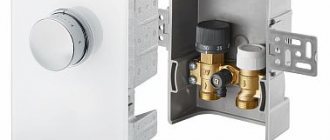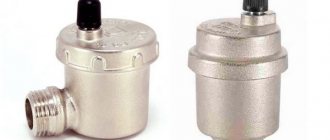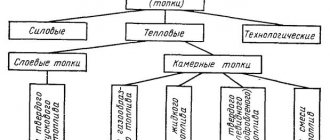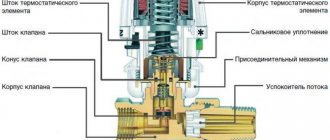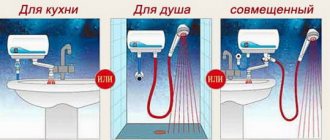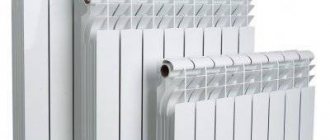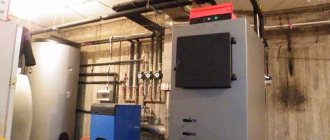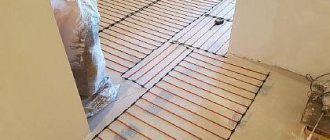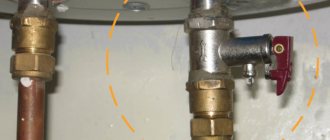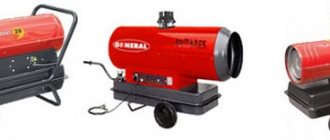The coolant circulating in the heating radiators provides us with heat during the cold season. However, situations often arise in which the battery does not warm up completely. They arise due to the accumulation of air in the far part of the radiator, which prevents the radiator from filling with hot water. Therefore, it needs to be removed somehow. For this purpose, a Mayevsky valve is used, the operating principle of which is based on bleeding air pockets when the shut-off cone valve is loosened.
The Mayevsky tap is installed at the top point of the heating radiator. It can be controlled automatically or manually. When the valve is opened just half a turn, the air in the system comes out of it, freeing up space for the coolant. This device is used on all types of radiators, including old ones.
Where does the air come from in the system?
Air locks inside the heating system inevitably appear in the following cases:
- when a new heating system is being installed;
- in case of repair of the system and removal of water from it;
- when installing new radiators;
- when air is sucked into the system during its operation;
- when there is a gradual release of air bubbles from the water, which is a natural physical phenomenon;
- in the presence of corrosive processes, which are accompanied by the release of a certain amount of air. Aluminum heating radiators are especially susceptible to such processes in city apartments.
Design and operating principle
First of all, let's explain what a Mayevsky valve is - a service valve designed for manually bleeding air at certain points of the heating system. A modern example of a faucet, shown in the drawing, includes the following parts:
- brass body with nickel plated;
- locking screw with a conical tip;
- nylon cap with outlet;
- O-ring made of plastic or EPDM rubber.
The plate can be rotated and the outlet channel can be directed in the desired direction.
A calibrated hole with a diameter of 2 mm is drilled in the end of the body, and a connecting pipe thread is made on the outside. Inside the housing there is a chamber with a side exit into which a locking cone screw is screwed.
The tap operates on the principle of a needle valve - when the screw is tightened, the main hole is sealed with a cone-shaped tip. To ventilate the system, the screw is unscrewed, the cone opens the flow area, then the air along with water comes out through the side channel. The position of the outlet is adjusted by rotating the plastic cap.
Historical reference. The manual air separator was invented by the Russian engineer Ch. B. Mayevsky in the 30s of the last century. The invention served as a replacement for conventional water valves used to remove air pockets from centralized heating networks. The installation of new taps made it impossible for unauthorized withdrawal of hot water from the system.
What the old Soviet Mayevsky valve looks like is shown in the diagram. The official name of the plumbing element is needle-type radiator air valve STD 7073B.
Technical characteristics of Mayevsky air separators used in water heating systems of private and apartment buildings:
- maximum operating temperature – 120 °C;
- liquid medium - prepared water or non-freezing coolant (antifreeze);
- operating pressure – up to 10 Bar (1 MPa);
- connecting dimensions of pipe thread – ¼”, ½”, ¾”, metric – M10 pitch 1 mm;
- The service life of a product made of high-quality brass is at least 30 years.
Note. For more extreme operating conditions, there are models of taps designed for a pressure of 16 Bar (marking according to GOST - Ru16) and a liquid temperature of +150 degrees.
Design and operation of the Mayevsky crane
The classic Mayevsky tap is made of brass alloys that are resistant to corrosion. It is a housing containing a cone needle valve inside. This Mayevsky valve is controlled by a shut-off screw, adjustable from the outside. When in the closed position, the valve is able to reliably hold the coolant inside the radiator. When the screw is turned to the side, the passage hole of the faucet opens, releasing the air inside the heating device.
Outside the metal body there is often a white plastic casing, giving the faucet a more noble and modern look. The design of the product may differ in its individual modifications, but the principle of operation of the Mayevsky crane always remains unchanged. The devices differ in external thread diameters , making it possible to easily select the appropriate option for any radiator. There are taps with 1 inch, ¾ or ½ inch threads.
To control the adjusting screw, use a key for a Mayevsky tap or a regular screwdriver. A square wrench is convenient because it takes up little space, allowing you to control the adjusting screw even if the radiator is in a hard-to-reach place.
Mayevsky air valve with key
In some cases, the operation of the crane can be controlled without the use of tools at all. To do this, just turn the valve by hand, ensuring that the air begins to bleed.
How to change the Mayevsky tap on a heating radiator?
Hello, our regular reader!
The concept of housing for a modern person necessarily includes a comfortable temperature in both winter and summer. In our climate, living in a house or apartment without heating in winter is simply impossible. The most common problem with a cold heating system is the presence of air in radiators and pipes, and for bleeding it there is a special device - the Mayevsky valve.
Varieties
There are three types of air vents, differing in operating principle and design:
1. Mayevsky manual tap . This is the simplest device that is controlled manually. If uneven heating of the radiator is detected, the tap can be opened with a key or any screwdriver, and then, as air leaves the radiator, turn the tap in the opposite direction.
The photo shows a Mayevsky manual type crane
2. Automatic tap . The difference between an automatic crane is the absence of manual control of its operation. Its design and operating principle are somewhat different from the functioning of a manual crane. An automatic faucet is made of brass in the form of a cylinder, but there is no needle valve in its design. Instead, a plastic float is used. How does an automatically controlled Mayevsky crane work? A plastic float, depending on the presence of air in the system, moves inside the tap and controls the opening and closing of the valve. Everything happens without human intervention.
The principle of operation of the Mayevsky automatic crane is visually demonstrated in the photo above.
All automatic taps have the ability to be manually controlled, which can be used when the passage opening becomes clogged.
3. Crane with built-in safety device . For this type of Mayevsky crane, the principle of its operation is somewhat different from the usual bleeding of air. The safety valve is able to control the coolant pressure in the system. If the coolant pressure exceeds the limit value, reaching 15 atmospheres, the valve will operate and begin to forcibly bleed the coolant from the heating system. This prevents damage to individual elements of the system in the event of sudden water hammer.
It is especially important to install air vents with safety valves in heating systems made of polypropylene and metal-plastic pipes, which may not withstand high pressure.
Advice for business
Before deciding to purchase air exhaust devices, it is recommended to carefully study the arrangement of devices in the heating circuit.
Small-sized special keys are convenient to use in cramped conditions, where the use of a screwdriver is hampered by nearby other objects
Depending on the degree of freedom of access to the equipment, Mayevsky cranes of a suitable modification should be installed.
Where it is difficult to work with a screwdriver, turnkey models are better suited, and where it is difficult to work with keys, it is wise to place automatic devices. Careful analysis will help make device maintenance more efficient and save on purchases.
Automatic air vents are traditionally installed on pipeline lines, at points of potential accumulation of air masses. Such devices, as a rule, are not used on radiators.
Manual devices have the most simplified design, for example, compared to automatic air vents. But, as practice shows, simplicity is the key to reliability.
If cast iron radiators are used in the heating system, manual taps are more reliable for such a system than automatic ones. Meanwhile, the degree of reliability of the design largely depends on the quality of the metal (brass) from which the air vent is made.
Mayevsky tap assembled with a nylon plug. Design specially prepared for installation in a system built on polypropylene pipes
You can also mention the experience of introducing Mayevsky taps into heating circuits built on plastic pipes. This material quite reliably maintains stable pressure and temperature, but is weak against water hammer.
Installing a Mayevsky crane paired with a safety valve or a full-fledged safety group increases the reliability of the system for such cases. In general, for circuits where pressure stability is in question, it is recommended to use taps as stabilizers.
Features of choice
When choosing a device model, you should consider some features of radiators:
- For centralized heating systems, the best solution is to use manual taps, which can be used to bleed air at any time. It is not advisable to use automatic taps in apartments or houses with centralized heating. The coolant in such systems is highly contaminated, as a result of which the tap hole will constantly become clogged with dirt;
- Automatically controlled faucets are good in private homes with autonomous systems, because the coolant is kept clean there. It is also recommended to install automation in places with difficult access;
Automatic air vent on battery - If the heating device is installed in some kind of recess or niche, then access to its end may be limited. In this case, it will be impossible to unscrew the screw with a regular screwdriver. Therefore, it is recommended to use an automatic Mayevsky tap for such a radiator. Or use a special key, which is located in the same plane as the battery;
- Many rooms still use old-style cast iron radiators. In this case, it is possible to install a manual Mayevsky valve for cast iron radiators, but it is better to use special automatic air vents made of brass, which have significant strength.
Mayevsky's manual tap on a heating radiator made of cast iron
How to choose the right device?
To choose the appropriate model of the Mayevsky crane, you need to assess the condition and capabilities of your heating system, as well as the features of the placement of radiators. Simple manual models are suitable almost everywhere. It should be remembered that some space will be needed to rotate the control screw: more - for working with a screwdriver or pliers, less - if the valve is opened using a special key. In radiator niches, space can be very limited.
Automated models will be very convenient precisely for such cases with limited access to the radiator, placed in a tight niche or hidden by a decorative screen. However, the use of automatic air vents is not recommended in houses with a centralized heating system.
Usually in such houses the coolant is so contaminated that the tap hole soon becomes clogged. The device will have to be cleaned once a month or more often, which will negate all the convenience of its use. In addition, interruptions in the coolant supply with centralized heating occur quite often, so more unnecessary air accumulates in such a system than with autonomous heating. The process of bleeding air through the two-millimeter hole may take too long.
For the same reasons, you should not install automated models on old cast iron radiators. For them, it is recommended to use special models in a brass case, for example, MC140 according to GOST 9544-93. This device can withstand temperatures up to 150 degrees and is suitable not only for liquid coolant systems, but also for steam heating.
It is recommended to install special Mayevsky tap models on old cast iron radiators, which are made of brass and have increased strength.
Air vents with a safety valve are recommended for installation in PVC pipe systems. These structures are sensitive to water hammer and installing a crane will prevent rupture. These models are also effective in central heating systems that are often subject to sudden pressure changes.
How to install a Mayevsky crane
The installation of the tap must be carried out in the upper part of the radiator device on the side opposite to the flow of coolant, since it is in this place that air collects. The specifics of each system should be taken into account. If a vertical heating system is installed in the house, then Mayevsky taps are installed on the radiators of the upper floor. In addition, air vents are installed on all heating devices that are connected to the riser below the upper connection axis.
When using a horizontal system, the taps are mounted on all heating devices without exception that can be connected to them.
If the Mayevsky tap is installed on a floor radiator located horizontally and parallel to the floor surface, then it is placed in the upper part of the highest point of the radiator. The adjusting screw points upward.
Many bathrooms have heated towel rails, which are heated by the coolant circulating inside them. On such devices a Mayevsky tap is installed for a heated towel rail. Installation has some peculiarities. If the heated towel rail has a bottom connection, then there is already a place for screwing in the tap. But for models with a side connection, it is necessary to modify it. A tee is cut into the supply pipe, into which the tap is screwed. The air outlet should be directed away from the wall. It is advisable to equip some models of heated towel rails with even two air vents.
Procedure for installing a tap on a radiator
1. Before installing the faucet, it is necessary to drain the water from the system.
2. Unscrew the plug located in the upper part of the radiator.
3. Screw the tap into place of the plug. The standard equipment of the faucet includes a rubber gasket that ensures the tightness of its installation. For a more reliable seal, it is recommended to screw FUM tape or oiled flax fibers onto the threads of the tap.
Tip: When installing the faucet, it is recommended to direct the air outlet hole slightly downwards. In this position, it will be more convenient to collect the water leaving the system, which will begin to follow the air.
If a tap is installed on an old cast iron battery that does not have a hole, then the following modification is performed. A hole is drilled in the cast iron plug, which has a slightly smaller diameter than the tap thread. The thread is cut inside the cast iron plug. After this, the air vent valve is fitted and screwed in.
In our separate article you will find photos of installing wall-mounted heated towel rails in the bathroom, as well as video instructions for installing it yourself.
The process of installing an expansion tank for closed-type heating is described in another material on the site.
You can read about making your own drainage well here.
Features of operation
Let's look at how to use the Mayevsky crane. To do this, it is advisable to place some kind of container under the battery and stock up on a dry cloth. Using a wrench or screwdriver, turn the locking screw counterclockwise a quarter or half a turn. Air will begin to hiss out of the system. When it comes out completely, water will flow from the tap. You must wait until the water starts flowing continuously. After this, the locking screw can be tightened.
Knowing what to do, bleeding air from the radiator is very simple.
If the air was successfully bled out, but the battery remained cold, then this is a sign of clogging. To clean a clogged battery, you will have to resort to the help of plumbers.
Tip: If the heating system includes pumps that force the coolant to circulate, they must be turned off 10 minutes before bleeding the air. When the pumps are turned on, air will not accumulate at the top point of the radiator, but will be carried throughout the system by the flow of water.
If the tap hole is clogged, it can be cleaned with a needle or other sharp object.
If the faucet has not been used for a long time, the rotation of the adjusting screw may be difficult due to the formation of corrosion on it. If this situation occurs, use WD-40 lubricant spray. Within a few minutes after applying it to the screw thread, it can be easily unscrewed. At the end of the heating season, it is advisable to lubricate the adjusting screw with silicone grease. In this case, the thread will not be destroyed by the influence of the coolant on it.
If you need to replace the Mayevsky tap, use two adjustable wrenches. Use one key to hold the cap on the radiator, and the other to unscrew the tap. If this is not done, then unscrewing the tap can weaken the plug and lead to loss of its tightness.
We looked at how to bleed air from the system using a Mayevsky valve yourself and how to operate an automatically controlled device. If you provide the necessary care to this device, check it and clean it in a timely manner, the device will serve for a long time without causing any problems to its owners.
The price of a Mayevsky crane depends on its type, material of manufacture, diameter, and starts from 30 rubles.
In what cases is it necessary to install a Mayevsky crane?
In open systems, the role of an air vent is usually performed by an open-type expansion tank.
Installation required:
- in heating systems where frequent airing of pipes and heating devices occurs:
- in closed heating systems;
- in two-pipe horizontal systems - description;
- in heated towel rails, etc.
With a vertical system wiring diagram in a multi-storey building (more than one floor), installing a shut-off valve on the radiators of the upper floor is also necessary.
Considering the low cost, reliability and practicality of the Mayevsky tap, its installation is justified on any heating system devices. This will improve the heat transfer efficiency of heating devices and reduce heating costs, especially in autonomous systems of private houses.
Automatic vent valve
Mayevsky taps are not used in main central heating systems due to the low quality of the heat-carrying fluid.
This leads to rapid clogging of the faucet and the need for frequent cleaning.
In central heating systems, powerful water hammers of tens of atmospheres often occur, which can lead to failure of the taps.
For the central system, special automatic air vent devices are used.
